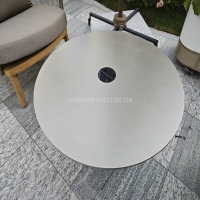Welcome to the website for landscape facilities products and knowledge.
Are there any restrictions on the table’s use in areas with extreme temperature swings?
Outdoor tables face significant challenges in environments with drastic temperature fluctuations. The fundamental issue lies in material science - most common table materials expand when heated and contract when cooled. This continuous thermal cycling can cause warping, cracking, or joint failures in poorly constructed tables.
Metal tables, particularly those made from aluminum or steel, experience measurable dimensional changes. While metals generally withstand thermal stress well, the repeated expansion and contraction can loosen fasteners over time. Powder-coated finishes may develop micro-cracks when subjected to frequent thermal cycling.
Wood tables present unique concerns. Natural wood absorbs and releases moisture with humidity changes that often accompany temperature shifts. This dual stress of thermal and moisture variation can lead to checking, splitting, or severe warping. Tropical hardwoods typically outperform softwoods in these conditions.
Composite materials and plastics have their own limitations. UV radiation combined with temperature extremes can accelerate degradation, causing color fading, surface chalking, or reduced structural integrity. High-quality polyethylene resins generally perform better than PVC-based materials.
Manufacturers address these challenges through engineered solutions. Expansion joints in tabletops, flexible mounting systems, and temperature-resistant adhesives help accommodate dimensional changes. Powder coatings with enhanced elasticity maintain surface protection despite substrate movement.
For optimal performance in extreme climates, consider these factors: select materials with similar coefficients of thermal expansion, ensure proper water drainage to prevent freeze-thaw damage, and provide adequate ventilation to minimize temperature differentials. Regular seasonal maintenance becomes crucial in these environments to detect early signs of thermal stress damage.
Proper installation location also plays a critical role. Tables placed in full sunlight will experience more extreme temperature variations than those in partially shaded areas. Sudden temperature changes, such as those caused by rainfall on hot surfaces, pose particular risks that quality outdoor tables should withstand.
Understanding your local climate patterns helps select the most suitable table. Areas with frequent freeze-thaw cycles demand different material considerations than regions with primarily hot daytime and cool nighttime temperatures. Consult manufacturers for specific temperature range ratings when selecting furniture for extreme environments.
Related search:

Recommendation
Outdoor stainless steel table with solar-powered ambient lighting feature - excellent design.